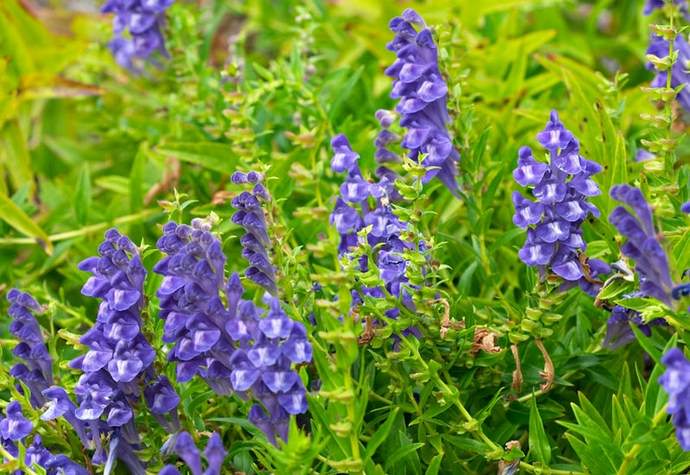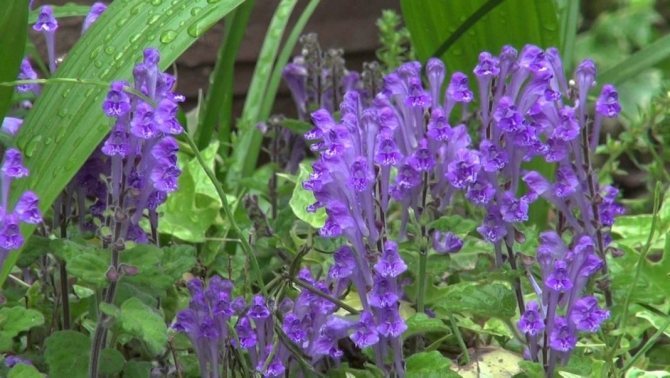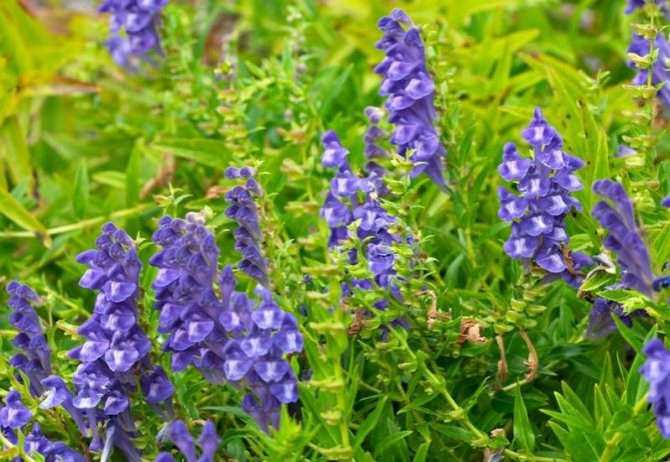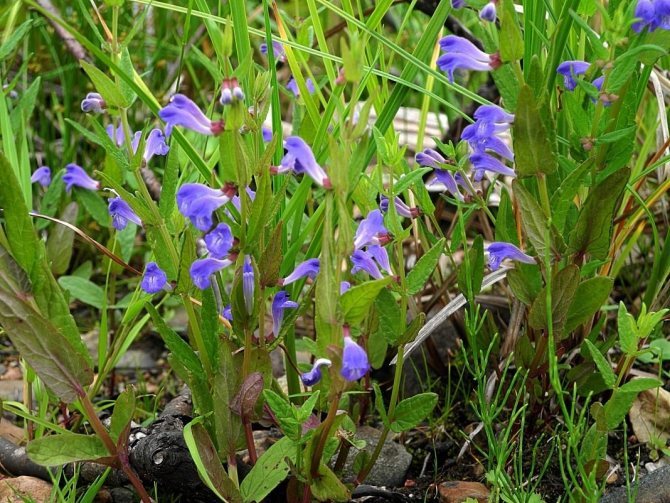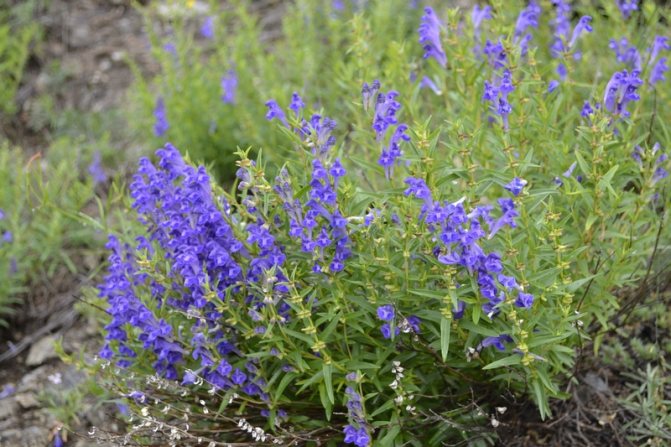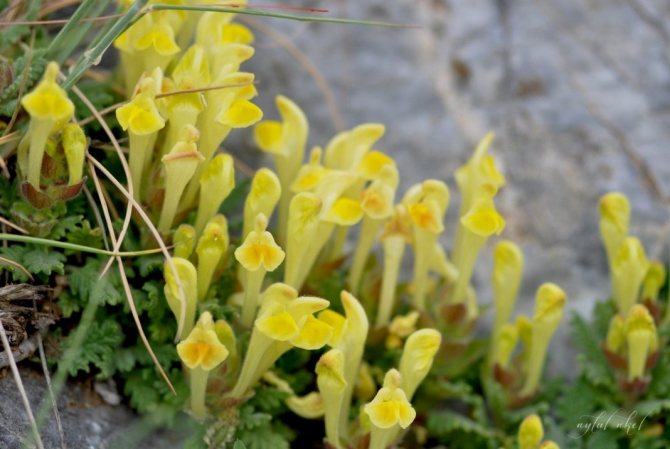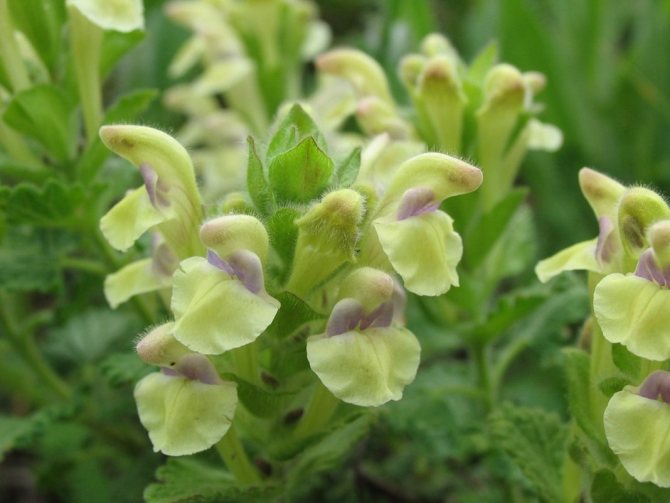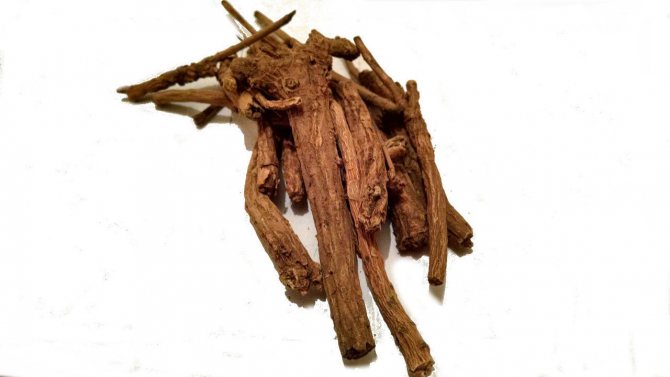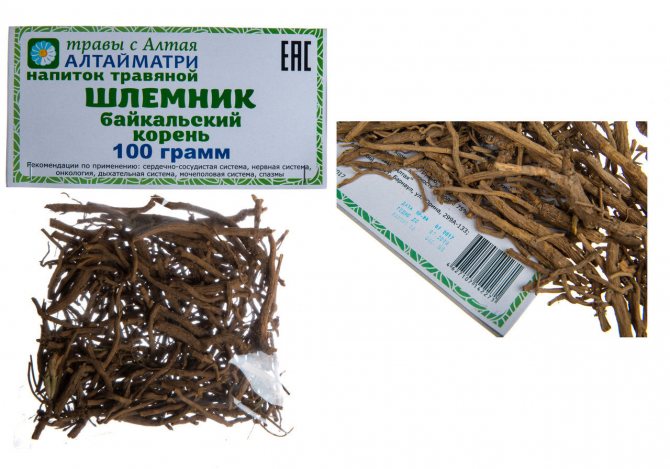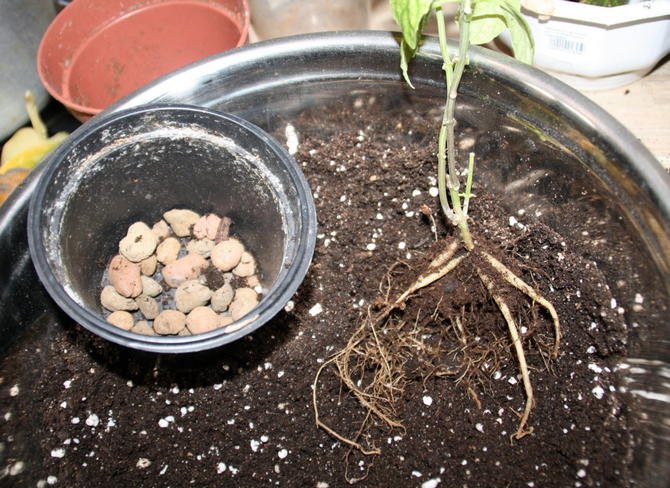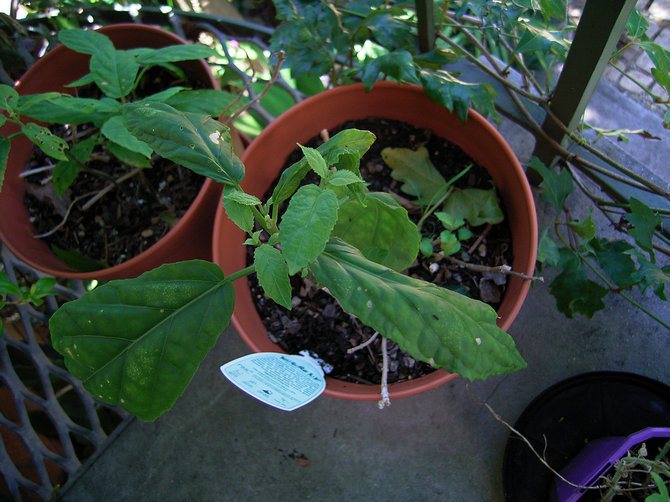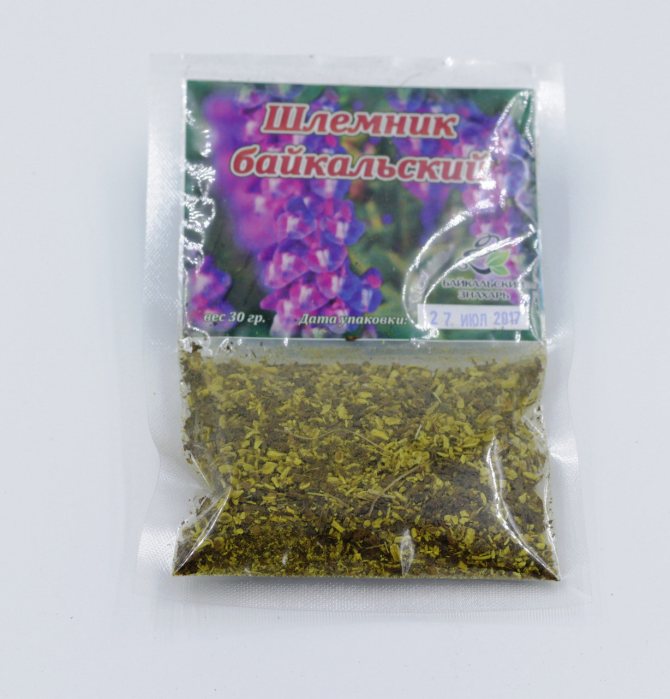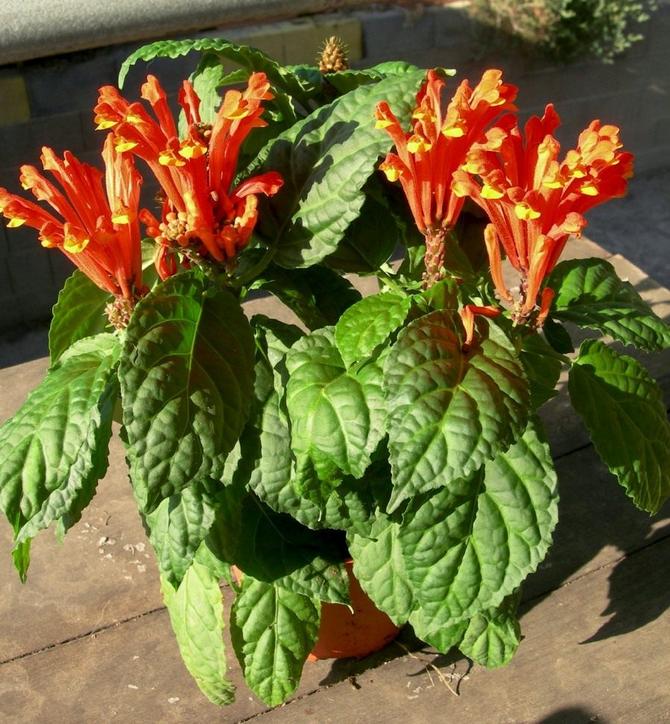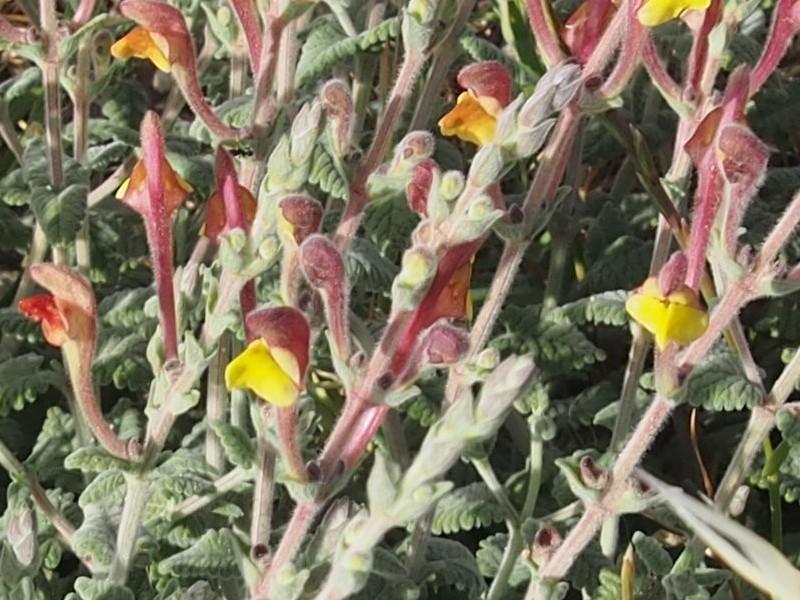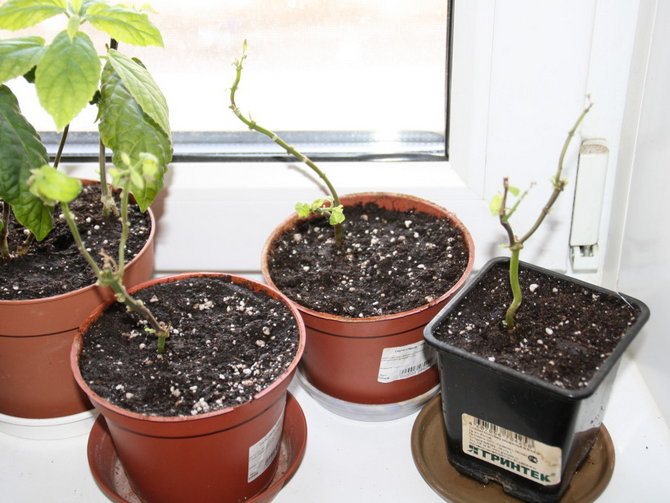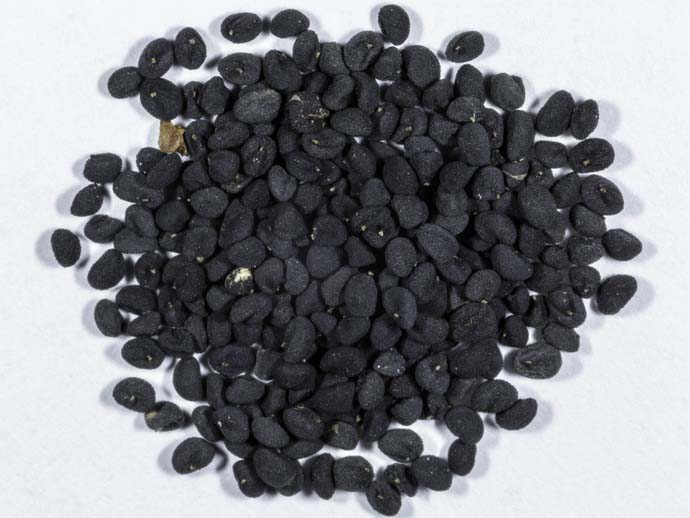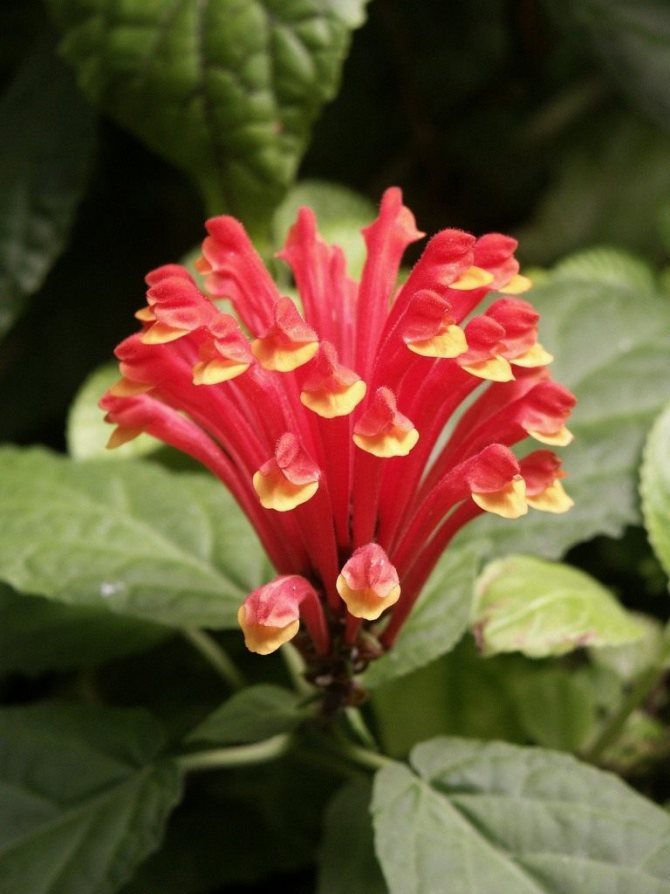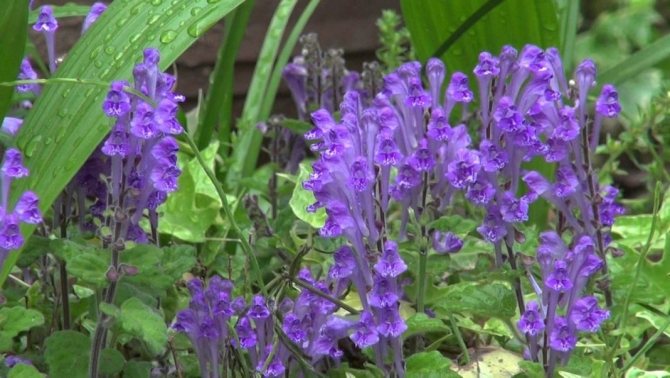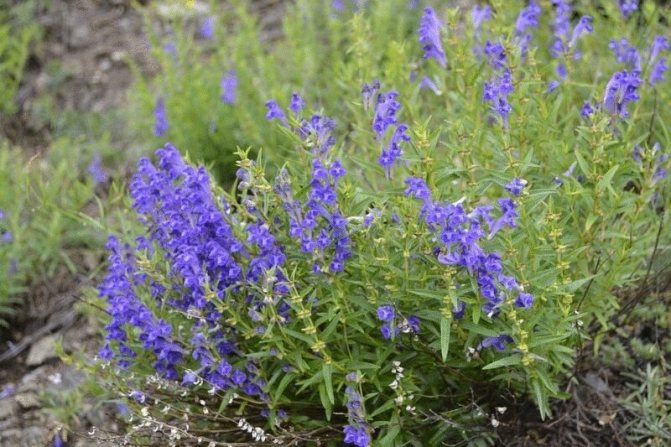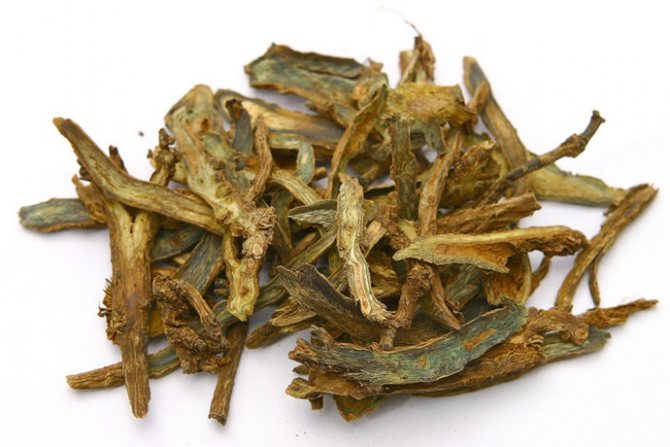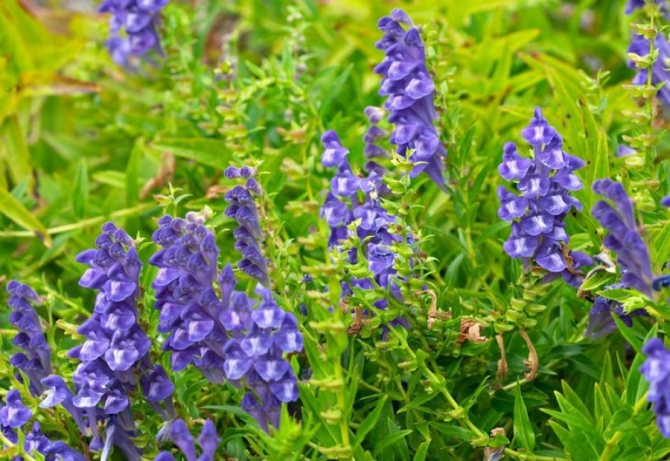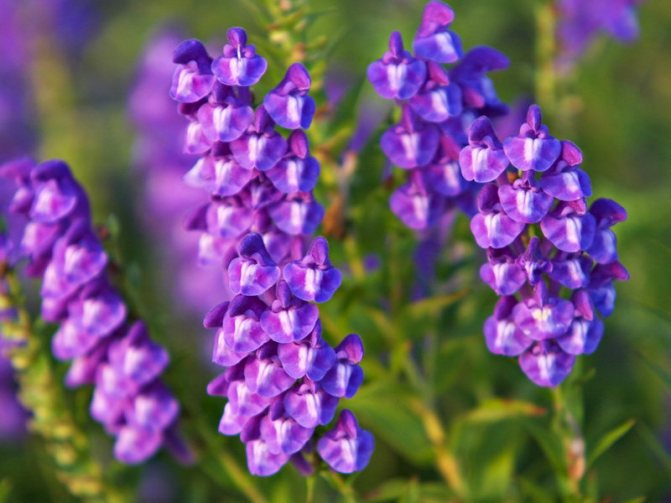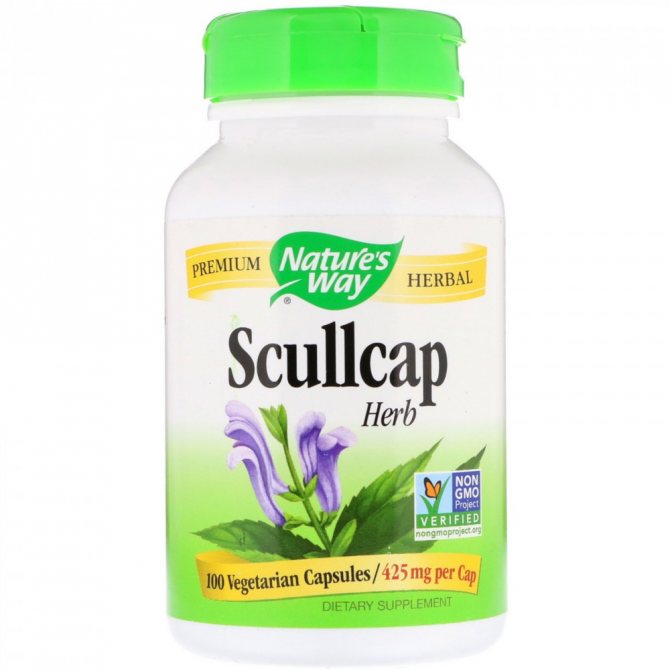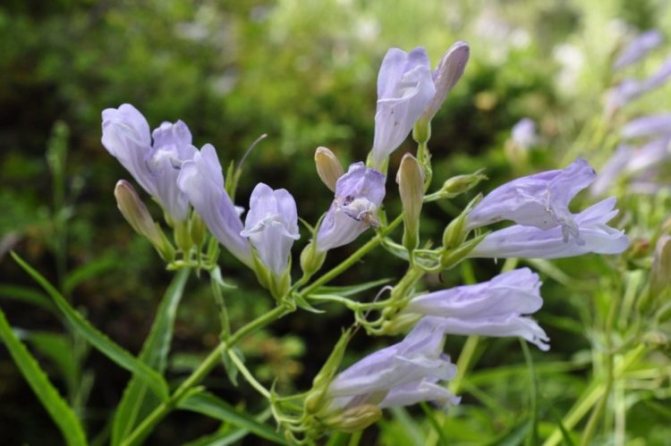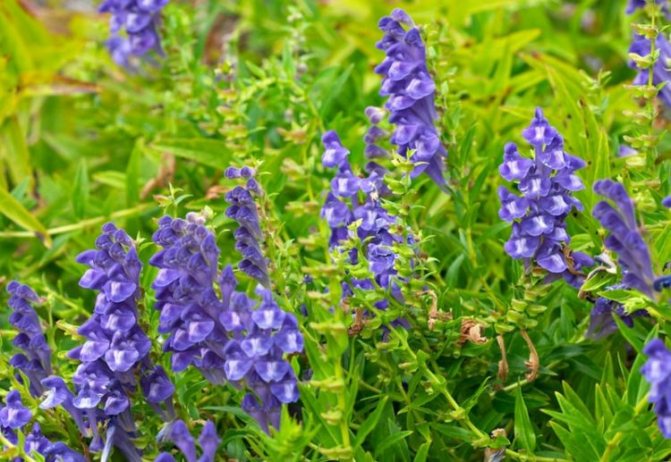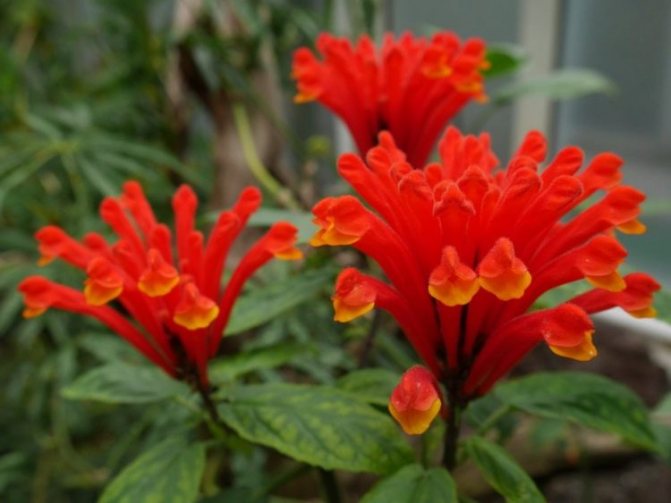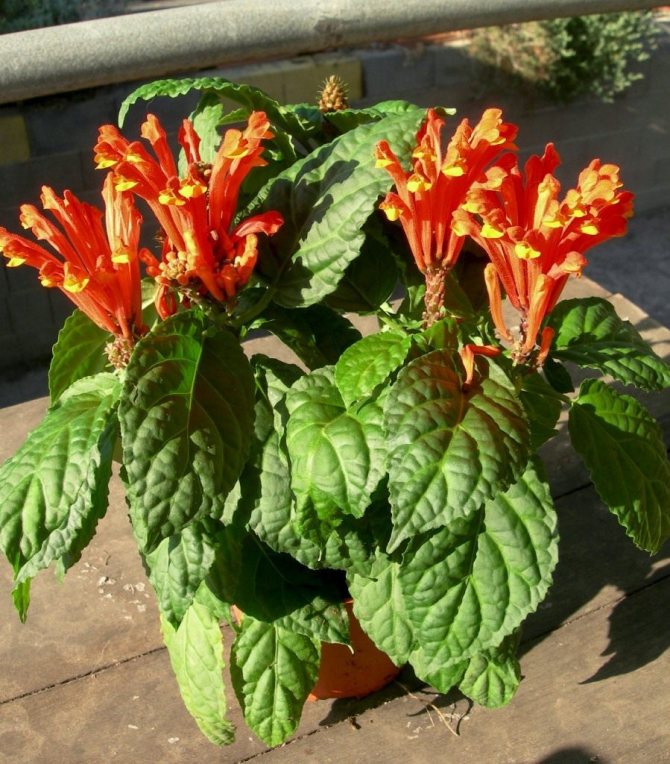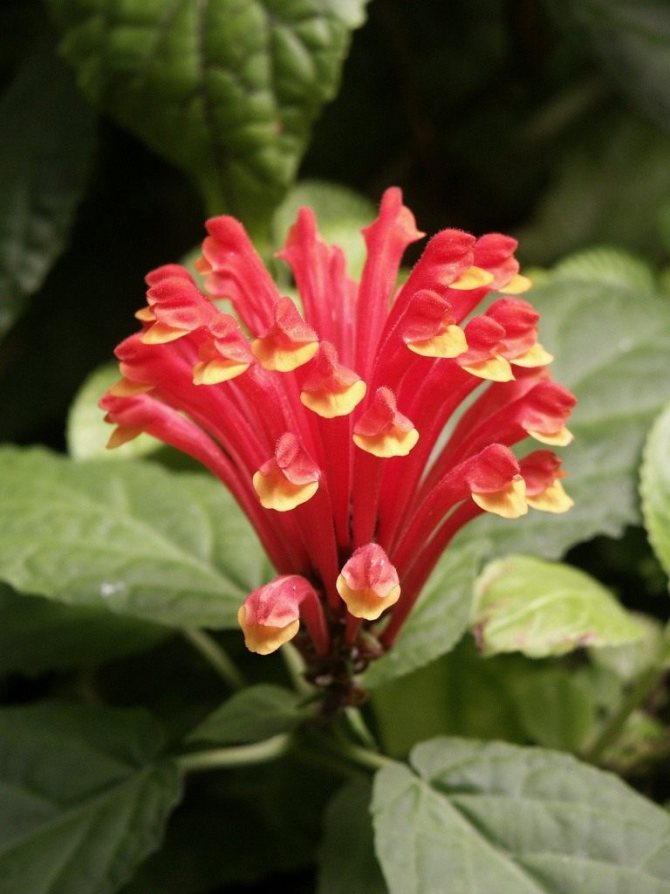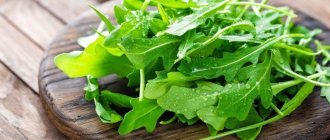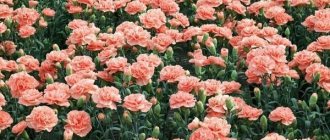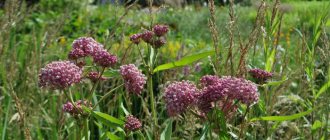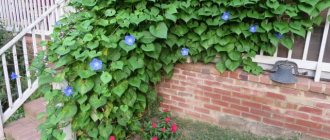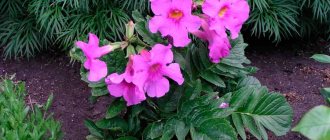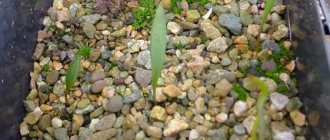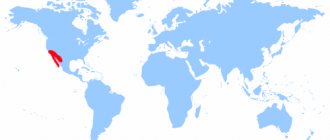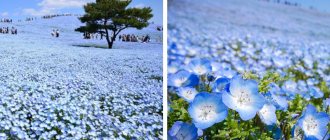Almost all types of crops are used as medicinal herbs, but breeders have bred several wonderful varieties and hybrids that are in demand in garden design. The color of their inflorescences can be pink, white, yellow, blue, lavender or purple.
3. Varieties:
3.1. Skullcap Baikal - Scutellaria baicalensis
Herbaceous plant with stiff, erect, profusely branched stems at the base with ribs. Leaves are green, linear, glossy, sessile or on very short petioles. The inflorescences appear at the tops of the shoots, bearing many small, delicate blue or purple flowers. The plant is widely used in folk medicine as an anti-inflammatory agent and is believed to contain high amounts of antioxidants.
↑ Up,
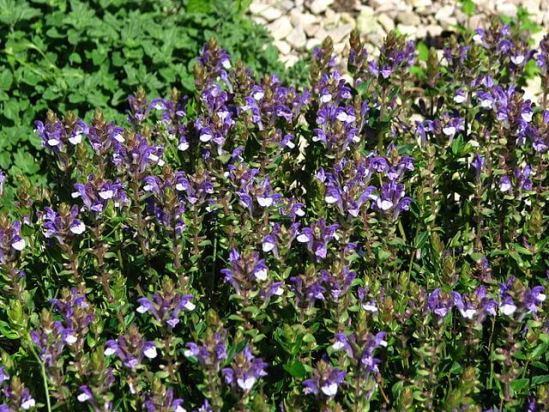
3.2 Common Skullcap - Scutellaria galericulata
Herbaceous plants with stiff, square in section, ribbed stems, covered with thin, sparse pubescence. The leaves are green, covered with a branched network of veins, glossy, 2 to 6 cm long, narrowly lanceolate, arranged in opposite pairs. The leaf blades have weakly pronounced denticles along the edges. The flowers are tubular, blue-violet, covered with delicate pubescence, axillary, appear in the upper part of the stems in two or three.
↑ Up,
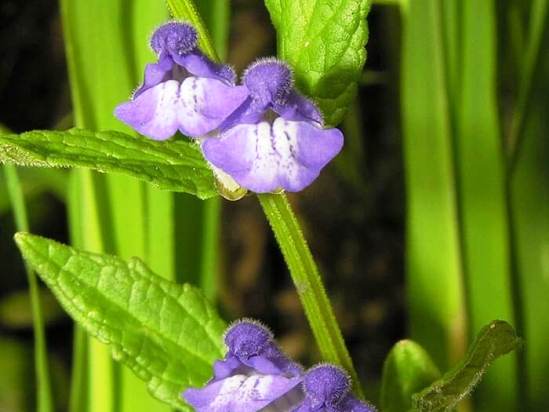

How to apply the plant
In traditional folk medicine, skullcap, known as Baikal, is used in three main types. This is a tincture on alcohol-containing liquids, a medicinal decoction and infusion. How to cook them yourself? Let's start with the tincture.
Tincture number 1
The tincture is prepared only from several types of skullcap, these are ordinary, Altai and Baikal varieties. This type of drug has indications for relieving fatigue, also helps with heart disease, neuroses. Has an effect on colds, as well as viral flu and whooping cough. How to cook:
- Take 50 grams of prepared skullcap rhizomes. They should be crushed and placed in a dark glass container.
- Pour 70% alcohol over the roots, it will take one glass. This type of cardiac skullcap is used with caution due to its high alcohol content.
- Remove the container containing the infused Baikal skullcap in a dark place and leave there for 2 weeks. Check the bottle regularly by shaking it.
- After a lapse of time, this tincture can be used for medicinal purposes. The usual dosage in this case for an adult is to dissolve 20-30 drops of tincture in a small amount of water 2-3 times a day and drink.
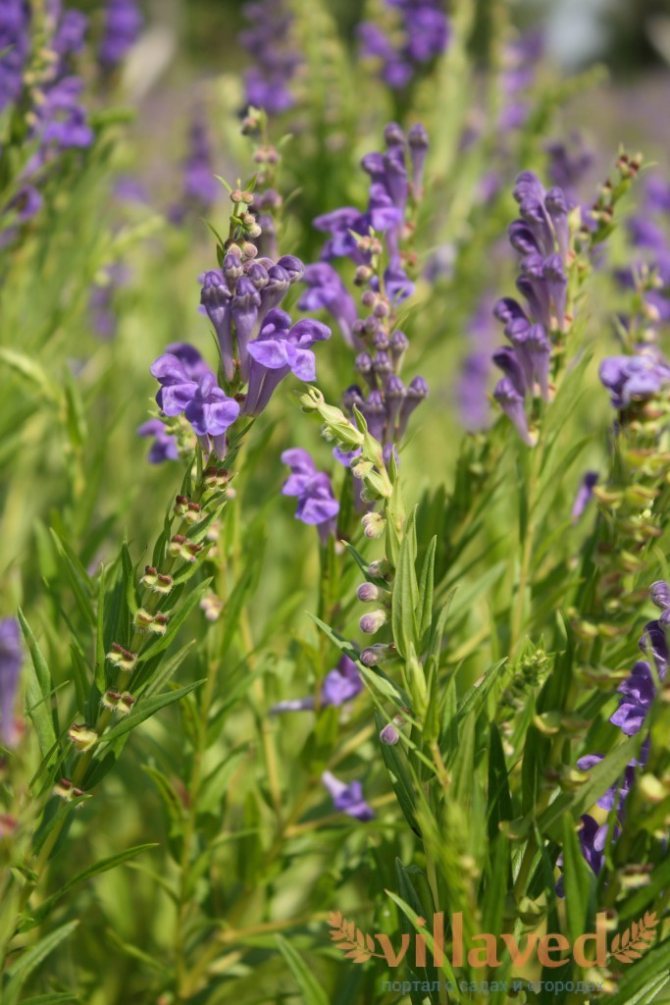

Chinese skullcap
Skullcap in the form of this tincture will also help in relieving the symptoms of menopause, inflammation of the intestines, as well as with other inflammatory processes in the body, including inflammation of the genitourinary and excretory system. Also, the tincture can be used in cosmetology.
Tincture number 2
This skullcap recipe will help with heart disease, as well as epilepsy, insomnia. It will also help with chronic bronchitis, cough, whooping cough, pneumonia. It is also shown for dysentery.
To prepare it, you will need to pour the ground roots of the plant with vodka in the proportion of one part of the roots to ten parts of vodka. It will take 21 days to insist in a dark place, periodically shaking the bottle. This tincture should be taken with appropriate indications, 20-30 drops 3 times a day.
Tincture of useful skullcap will also be effective for hypertension, headaches, migraines, rheumatism. The usual course is 1 month of daily intake of the drug. If after the end of the course there is no improvement, you can repeat the course of taking the tincture after a two-week break.
Method number 3
Baikal skullcap in powder form. To do this, crush the peeled and well-dried roots of the plant into powder and take it 1-2 teaspoons three times a day. Helps with insomnia, hypertension, overexcitation. On the basis of the powder, the Relaxen dragee has been created, which has all the useful properties of skullcap. Also, tablets made from plant powder are in great demand.
Medicinal use
One of the 50 main herbs used in traditional Chinese medicine for over 2000 years. The Baikal skullcap is mainly used for inflammation or infection, as well as for calming the nerves and reducing anxiety. Also used to treat:
- fever;
- jaundice;
- dysentery;
- diarrhea;
- urinary tract infections;
- liver disease;
- prostate cancer;
- respiratory infections;
- arthritis.
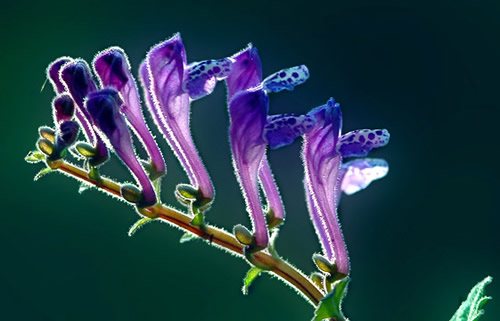

Modern research has discovered a significant efficacy of the active chemicals found in the root of this plant. However, these studies have not been sufficiently conducted to determine the effective dosage level and the precise benefits of each ingredient.
Potentially, these substances have antibacterial, anti-inflammatory, anti-cancer, anti-anxiety, antihypertensive properties. They also reduce anti-allergenic activity, sedation and anxiety, and help with respiratory ailments including hay fever and allergic skin conditions such as eczema and psoriasis.
The Baikal skullcap is of little low-order toxicity, as most people are unlikely to suffer from normal use. The active ingredients in this plant can react with alcohol and certain medications, including lithium, sedatives, and statins are used to treat high cholesterol and diabetes. In some people, this plant causes drowsiness, an allergic reaction, or leads to liver problems. The Baikal skullcap should be avoided by pregnant or breastfeeding women.
Scutellaria baikal root
The root of the plant is used for traditional medicine. The active ingredients take time to accumulate, so the roots should only be harvested on 3-4 year old plants, preferably in spring and autumn. The collected roots should be dried in a partially shaded and well-ventilated area. They can be used whole or cut. Note, however, that good quality roots should be brown on the outside and yellow on the inside, not green or black.
It is cultivated commercially due to the high levels of flavonoids found in the roots of 3-4 year old plants. Active chemicals include baicalin, wogonin, and baicalin.
Planting and leaving
This plant is unpretentious in care, it is mainly sown by itself and grows like a weed. For sowing, it is necessary to select mature seeds and sow in prepared soil. This can be done both in autumn and spring. Skullcap Baikal care and cultivation are not difficult.The sowing hole should be no deeper than 2.5 cm. Reviews of folk healers recommend placing the seed in calcined sand for 2 months for better germination before sowing. Seedlings will appear in 2-3 weeks. The plant needs to be watered lightly, but often. In the first year, it may not bloom. A useful shrub will give the most effective medicinal properties for 3-4 years of life. The medicinal root is harvested in August, kept cool. It is suitable for use for 3 years.
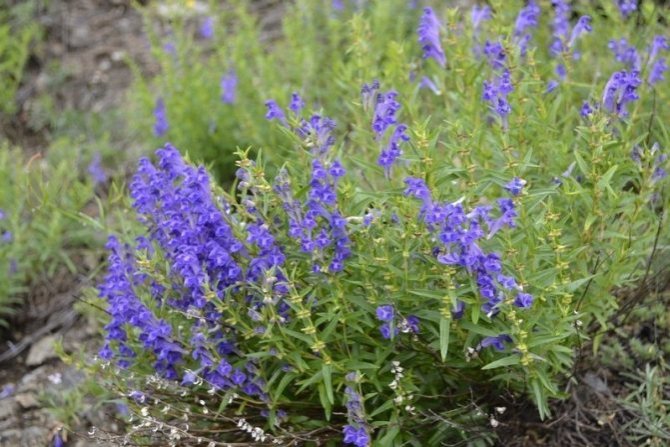

Rules for the collection and storage of plant materials
It is recommended to harvest plant raw materials at the end of the summer period. The procedure must be carried out as follows:
- Wear gloves.
- Dig up mature plants with 5–6 stems.
- Shake the roots off the ground and cut off the shoots.
- Rinse raw materials under cold running water.
- Spread the stems and rhizomes in a thin layer on paper and remove to the attic or under a canopy. Turn them over periodically.
- Inspect the raw material after it has dried and clean it from rotten parts.
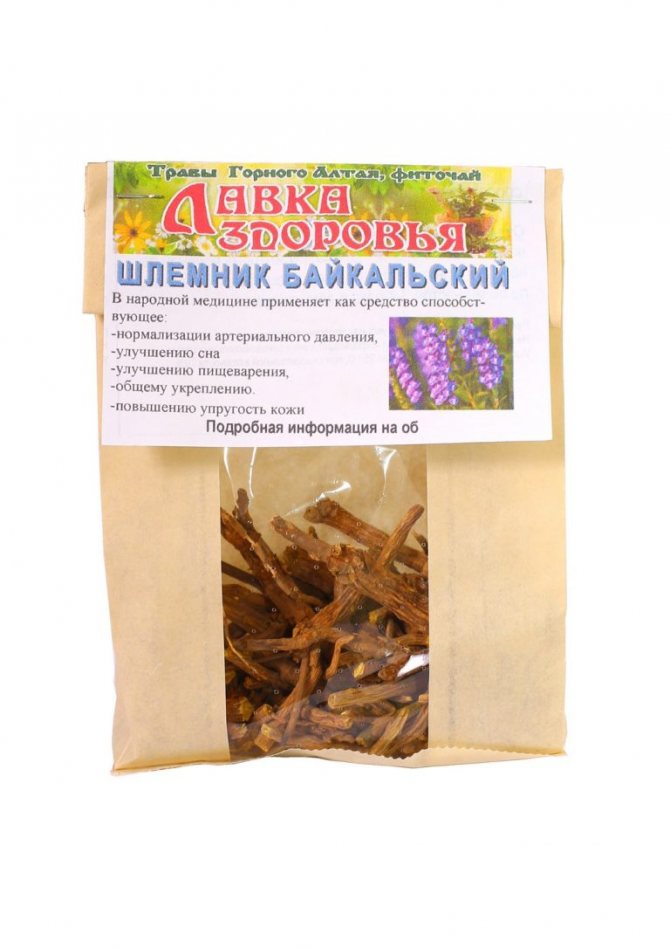

You can store plant materials in paper bags.
It is recommended to store dried blue St. John's wort in glass jars or paper bags for no more than 3 years. High-quality raw materials have a characteristic bitter taste and brownish tint.
Blank
The roots of the plant begin to be harvested in August, you can continue until the first snows in late autumn. When harvesting, the rhizome is dug out of the ground with a shovel, excess adhered soil and the aboveground part of the plant are removed. The medicinal raw materials obtained in this way are collected and dried either in dry rooms or in a special electric dryer at a temperature not exceeding 40 degrees.
Before drying, it is necessary to cut the rhizome into several parts. After drying, the resulting raw material can be stored for about 3 years, during which time it will not lose its medicinal properties. By the way, the best extract of the Baikal skullcap is prepared from the roots, which are already a year old. It is necessary to store it in a container made of natural natural material, metal and plastic will not work, it is optimal to use wooden or textile containers.
Scientifically at the moment, it has been established that the plant, called skullcap, reduces the number of headaches and pain in the heart with prolonged use. Also, many who took the drugs noted an increase in performance and a decrease in fatigue. Moreover, the last two effects can be pleasant side bonuses when taken from some kind of disease.
Siberian skullcap is good for constipation and bile stagnation. And the ointment, which is based on skullcap Baikal, has an anti-inflammatory and antimicrobial effect and helps wounds heal faster. Growing from the seeds of this plant is carried out when it is used as a decorative element in the garden.
What it looks like and where it grows
Despite the fact that Scutellaria Baikal is a popular medicinal plant all over the world, it is not found everywhere in nature. This plant belongs to the Lamiaceae family and is a representative of the large genus Shlemnik, represented by 460 species. Skullcap Baikal is a herbaceous plant with a long-term development cycle. In its natural environment, it grows in the eastern part of Europe and in Asia.
Botanical characteristics:
- the root system is well developed, pivotal, extends down to 1 m;
- plant height - about 50-60 cm;
- stems are thin, straight, sometimes branched;
- leaves are opposite, linear;
- paniculate inflorescences;
- flowers are asymmetric, purple.
The Chinese skullcap is unpretentious, so it can grow quickly in any conditions. The plant prefers sandy loamy soils with a neutral Ph. It can be grown at home if transplanted by dividing the rhizome, cuttings. If planted with seeds, the plant will take a very long time to mature.
Views
The genus Shlemnik has more than four hundred species, but not all of them are of therapeutic value. The Baikal skullcap is the most significant species for alternative medicine. Also, the following types are often used:
- ordinary;
- squat;
- spear-shaped;
- Altaic.
Due to the fact that these varieties contain fewer active components, it is more expedient for therapeutic purposes to choose Skullcap Baikal as the most effective medicinal plant representing this genus.
Collection and storage
It is possible to independently collect plant materials for the purpose of harvesting only in safe places. Even the most useful medicinal plants can be potentially dangerous to human health and life, if the basic collection rules are not followed.
- Harvest safe plants only in an area away from highways. Plants are toxic near highways and highways, as they accumulate heavy metals and other poisons from car exhaust gases.
- It is forbidden to collect medicinal raw materials in places located near industrial enterprises and factories. Herbs can also be toxic, accumulating toxic substances.
- It is strictly forbidden to collect raw materials in regions with an increased radiation background, since the plants will be potentially dangerous and carcinogenic, which can cause enormous damage to the body.
- Collecting near cemeteries, cattle burial grounds and animal husbandry facilities is also prohibited.
- Since Scutellaria Baikal is a perennial, and collection involves digging with a root, you need to leave 2-3 plants on each square meter of thickets.
- You can only harvest mature plants, which are at least 6-7 years old, with at least 5 mature stems.
- It is not worth collecting in the same place every year. You can return to the old place after at least 7-8 years.
- It is necessary to start harvesting no earlier than mid-September. By this time, the Baikal skullcap has time to completely seed, and the active substances in the rhizome accumulate in maximum concentration.
Knowing the basic rules, you can wait for the season and start collecting raw materials. In order to be able to obtain high-quality medicinal raw materials, you must follow the following instructions:
- Carefully dig out the roots with a shovel together with an earthen clod so as not to damage them.
- Cut off the aerial part of the plant immediately.
- Shake the roots off the ground, but under no circumstances wash.
- Dry raw materials for 14–20 days.
- After drying, sort out the roots, remove the damaged areas.
- Grind and transfer to a glass jar with a lid for storage.
You can also store raw materials in natural fabric bags. But in this case, it is important to maintain a stable air temperature and humidity in the room. Also, in the room where skullcap rhizomes are stored, there should be no extraneous sharp odors. The maximum shelf life of raw materials is 2 years. But if mold has appeared on the rhizomes or they have become wet, such raw materials cannot be used for medicinal purposes, even if the shelf life has not yet expired.
We advise you to read:
what does the goldenrod look like and where does it grow?
To read
Growing conditions
The Baikal skullcap prefers sunny places, if possible with slightly fertilized, dryish soil. The effectiveness of the active chemicals in the roots is much greater when grown in poor sandy soils. The plant has an average water requirement and is drought tolerant. It is quite hardy, therefore it easily tolerates low temperatures and frosts. Temperatures in their natural habitat are usually quite low.
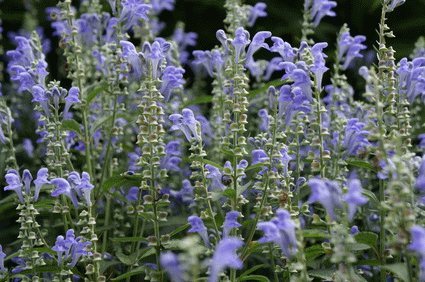

Although this herb is perennial, it is advisable to replenish it with new plants every three years.Seeds for the Baikal skullcap can be sown in spring or split before new shoots appear in spring. Large sections can be planted outright, while smaller sections can be stored in pots until ready to be planted in the garden. Woody or soft stem cuttings can also be taken, and many people successfully breed this plant this way. Skullcap is also suitable for growing in containers.
Specific developmental cycle of skullcap
Scutellaria is a very unusual plant. This beauty is prone to rapid degeneration and retains attractiveness in room form only for a maximum of 3 years without rejuvenation, or rather, replacing old bushes with young ones will not be able to enjoy exotic flowering. But due to such accelerated development, the skullcap acquires a different trait: in those three years, until it begins to lose its attractiveness, it is really irresistible all the time.
Even when the scutellaria is not in bloom, it still looks attractive. Of course, in winter, it also stops growing, but the cyclicity does not require either a change in conditions of detention, or a strong correction of care.
You can replace scutellaria with self-obtained specimens or newly acquired plants. But since it is easy to propagate skullcap, and it costs a lot, it is still better not to be lazy and provide yourself with a new generation of beauties at minimal cost. Be sure to throw away old specimens of skullcap: even their foliage ceases to be attractive.
Baikal skullcap: a cure for nerves (video)
Scutellaria contains many trace and macronutrients, including iron, selenium, iodine, molybdenum, manganese, cobalt, copper, zinc, potassium, calcium, and magnesium.
Vegetable raw materials have the following properties:
- sedative;
- vasodilator;
- antifungal;
- anticonvulsant;
- antimicrobial;
- anti-inflammatory;
- antipyretic;
- antineoplastic;
- antiallergic;
- hemostatic;
- astringent;
- immunomodulatory;
- fortifying;
- antihelminthic;
- choleretic;
- diuretic.
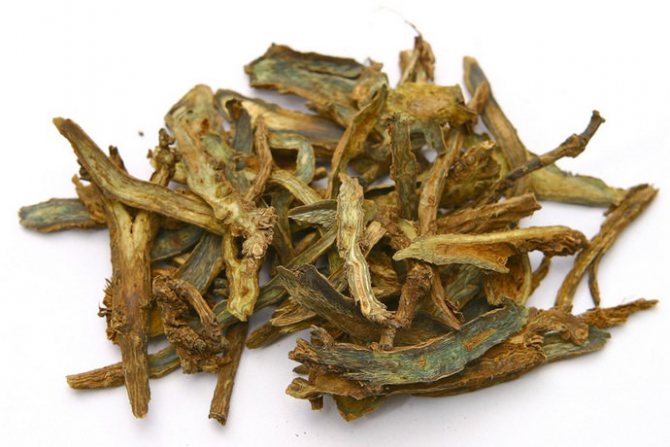

We also recommend reading:
The use of drugs and medicines based on skullcap allows you to restore health with the following problems:
- high risk of hypertensive crisis;
- hypertension stage I – II;
- violations of the functional state of the cardiovascular system and the central nervous system;
- convulsive conditions and epilepsy;
- fever of various origins;
- enlargement of the thyroid gland;
- anemia;
- acute rheumatism;
- hepatitis;
- stagnation of bile;
- colds;
- bronchitis;
- whooping cough;
- tuberculosis;
- stomatitis.
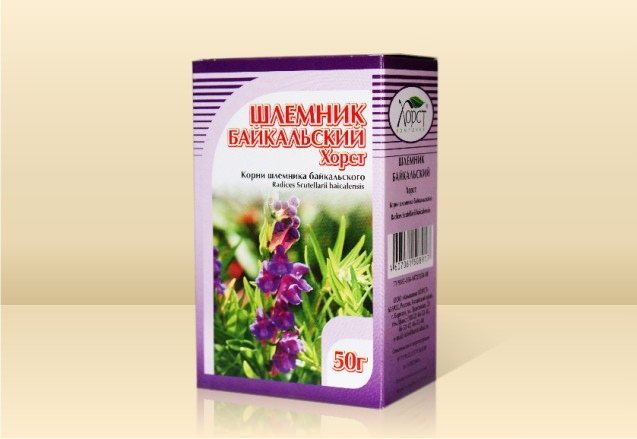

Scutellaria preparations are used to relieve panic attacks and hyperexcitability, in the treatment of insomnia, cardiovascular neuroses, pain in the heart and headaches. There are no direct contraindications to the use of drugs from scutellaria, therefore, the main conditions for effective treatment are compliance with the doctor's recommendation and the dosage prescribed by medical professionals. Among other things, you cannot use Scutellaria Baikal if you are allergic to the plant, as well as children under twelve years of age. Pregnant and lactating women must undergo a preliminary medical consultation.
Contraindications and side effects
Contraindications to the use of any products based on blue St. John's wort:
- children under 12 years of age;
- pregnancy and breastfeeding;
- hypotension;
- excess lithium in the body;
- individual intolerance.
The Baikal skullcap is considered poisonous and in case of an overdose of drugs based on it, the following side effects may occur:
- significant decrease in pressure;
- nausea;
- vomiting;
- intestinal colic.
If the above symptoms appear, you should immediately consult a doctor. An allergy test is recommended before using topical products. A little decoction or infusion made from blue St. John's wort should be applied to the skin and wait 20-30 minutes. If after this time a rash or redness appears, then the use of the product must be abandoned.
It is undesirable to combine the intake of medicines based on skullcap with the use of alcoholic beverages and sedatives, as this can lead to drowsiness.
Reproduction
Costa Rican scutellaria can be propagated by cuttings or seeds. Reproduction by cuttings is more popular with flower growers, since the likelihood of rooting and survival of the flower is higher.
Cuttings
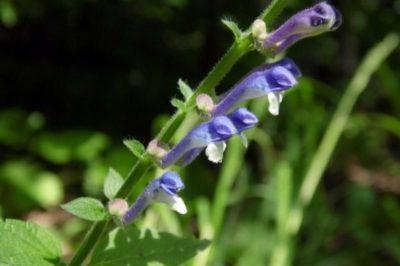

Cut young shoots are used as cuttings.- It is best to cut off shoots for these purposes in the summer, preferably at the end.
- The stalk for transplanting must be at least 10 cm and have at least two leaves.
- Cuttings are planted in a peat-sandy or peat-perlite wet substrate.
- Before planting, it is advisable to treat them with special rooting stimulants, for example, heteroauxin.
- To create greenhouse conditions, the container with cuttings is wrapped in plastic wrap or covered with a glass or plastic cap (a cut plastic bottle is suitable).
- For successful germination of shoots, it is necessary to maintain a constant temperature of at least 25 degrees, it is also advisable to use the bottom heating.
- The substrate must be regularly moistened and aired daily.
Seeds
This method is used much less often, but it is quite possible to propagate the plant in this way.
Feedback on the results of the use of funds
My friend became irritable while on diets. But when I began to take the Baikal skullcap, I became as calm as a tank. I really liked this story about the miracle of the herb that gives calmness and I also decided to try Shlemnik. I noticed the benefits of it immediately on the same day. I became calmer, my sleep and sleep strength improved, my general nervousness went away. Additionally, Skullcap has a beneficial effect on the work of the heart, and I noticed this property by stabilizing the pulse.
EFB
I often use various herbs to improve immunity. This time I bought a Baikal Skullcap. After I brew herbal tea, I divide it into two breakfast / lunch meals before meals. Skullcap is known for its medicinal effect on the body, as well as for its general strengthening effect, therefore I recommend herbal tea of this brand for use.
olesya21
Another acquisition of mine in attempts to get along with my insomnia is skullcap herb. I bought a dietary supplement made from roots, leaves and flowers. For the best sedative effect, I began to boil or simply brew the contents of two capsules and add to my evening herbal tea. My sleep has become deeper and I do not wake up a hundred times a night, but it does not help me fall asleep quickly, I still suffer for a long time while I fall asleep. In addition to its sedative effect, skullcap is a nootropic. It helps me with headaches, especially when the weather changes.
LILYUSHA777
Beneficial features
The pharmacological properties of Scutellaria Baikal are based on the action of the compounds described above, the plant has the following beneficial effects on the body:
- has antitumor activity (acts on benign and malignant tumors);
- reduces the risk of blood clots;
- removes free radicals, as it is an antioxidant;
- has antiviral and anti-inflammatory effect;
- strengthens blood vessels;
- stabilizes pressure;
- improves cerebral circulation;
- speeds up metabolism;
- calms the nervous system;
- eliminates intestinal spasms;
- accelerates wound healing;
- removes toxins from the body.
As you can see, skullcap has a huge set of useful properties, therefore, below we will describe the indications for the use of the plant. It will focus on diseases that traditional medicine can cope with.
The use of the Baikal skullcap in folk medicine
The healing properties of a useful plant are used for almost all diseases. Traditional medicine prepares a medicinal decoction from it, a water infusion and a vodka tincture. The herb Scutellaria Baikal is used in the treatment of ailments:
• hypertension and epilepsy; • cardiovascular neuroses; • fever and anemia; • enlarged thyroid gland; • rheumatism and hepatitis; • colds and bronchitis; • whooping cough and tuberculosis.
Another plant is able to relieve insomnia, intestinal inflammation and stomatitis. Reviews say that the broth should be drunk with late toxicosis during pregnancy.
Extract
This extract contains only the healing properties of the root. It can be purchased without any problems at a pharmacy at an affordable price. Skullcap Baikal extract is used to reduce the excitability of the central nervous system, relieve physical and mental stress. It is prescribed for hypertension.
Reviews of people say that the medicinal extract can be used externally. Nevertheless, it must be diluted with water so as not to burn the skin. The instructions for use state that adults and adolescents from 12 years old should take 20 drops of 3-6 r. for a day (based on the disease) before a meal.
The composition is preliminarily diluted in 1/3 stack. boiled but chilled water. You can take no more than 3 ml of liquid extract per day. Usually the duration of treatment is 4 weeks.
This drug has its own contraindications. These are children, pregnant and lactating women, as well as patients with severe liver diseases. Traditional medicine advises alcohol addicted people to refrain from drinking. The healing properties of Scutellaria Baikal in a liquid extract can cause side effects. They are similar to the symptoms of ethanol poisoning. Allergies, tachycardia and hypotension are also manifested.
Tincture
Useful tincture is used during colds and flu, it relieves inflammation of the intestines and urea. Its use will be effective for neuroses and diseases of the heart and blood vessels. Reviews indicate that alcohol tincture relieves insomnia better than a decoction.
Shlemnik Baikal tincture is prepared according to this recipe. You will need dried root and 70% alcohol, preferably medical. Chop 1 part of the roots, pour into a jar and pour 5 parts of alcohol. Insist 2 months in the dark, but do not forget to shake the product. Then filter, squeeze the liquid and drink 20 drops each. three times a day. Some reviews recommend taking the tincture in its pure form, and some insist on diluting it in water. In any case, the medicinal properties of the herb will act equally strongly.
Diseases
- Knowing about the moisture-loving nature of this plant, many growers water it too hard, which is why the water in the pots stagnates and the roots begin to rot. This is the most common scutellaria care mistake. With root decay, only correction of the irrigation regime can help.
- Another common problem is fungal infection. They also tend to develop from excessive waterlogging.
- Of the pests, aphids are the most dangerous. Less commonly, thrips and spider mites can infect the plant.
The Shlemnikov family is extremely diverse.... Among the species of Scutellaria, there are not only medicinal plants - there are also many ornamental species, however, for home cultivation, the most exotic one is the most exotic - Costa Rican scutellaria. This bright and beautiful plant, unlike most exotic plants, is easy to grow at home, which makes it even more popular.
Top dressing for skullcap
The plant develops actively and nevertheless quickly degenerates with any care. Therefore, it is better for skullcap to provide very active feeding, which allows it to grow both beautiful leaves and release spectacular lush inflorescences. Fertilizers for scutellaria are applied throughout the year, dividing the care program into two stages:
- active feeding from March to August (at this time, scutellaria is fed every one and a half to two weeks);
- modest supportive feeding from September to February (two to three times reduced dose 2 or 1 time per month).
For skullcap, use only fertilizers intended for flowering houseplants. Despite the attractive foliage, scutellaria belongs precisely to flowering plants and it does not need nitrogen in an increased dosage, but phosphorus and calcium.
Medicines based on the Baikal skullcap (video)
- for self-preparation of alcoholic tincture of skullcap, one part of the crushed plant material is poured into a container of dark glass and poured with five parts of 70% alcohol, after which it is infused for a couple of weeks in a dark and cool room. The strained tincture should be taken twenty drops diluted in 50 ml of water three times a day.
The tablet form of Scutellaria Baikal is a biologically active food supplement, without a prescription form. Quite often, in addition to skullcap, dietary supplements include additional components, which can be ascorbic acid and hops. As a full-fledged analogue of the Scutellaria Baikal extract, you can use a tincture prepared by yourself.
The well-known in our country "Ginkgo biloba" also contains Scutellaria Baikal and this remedy has proven itself very well in the treatment of discirculatory encephalopathy, memory impairment, dementia, Alzheimer's disease and other pathological conditions. Among other things, the drug is prescribed to improve memory. No less popular is the drug "Relaxen", based on skullcap with the addition of hops.
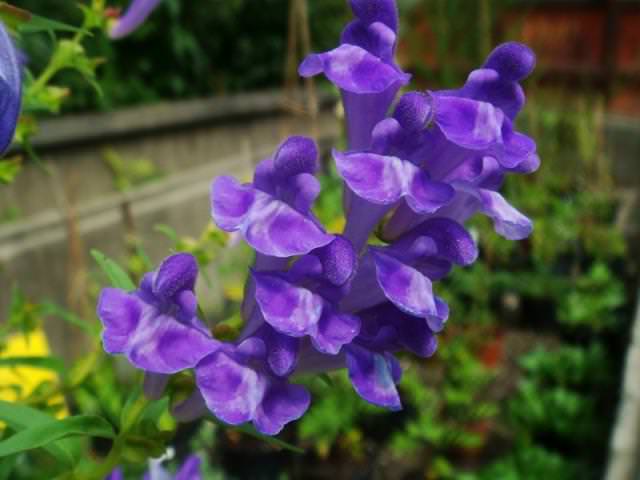

Recommendations and reviews
Common scullcap, Baltic, Altai are widely used in folk and official medicine in many countries. Numerous positive reviews about Scutellaria Baikal made infusions, extracts, capsules and tablets, as well as other preparations, very popular both in our country and among foreign consumers. Dry vegetable raw materials allow for the independent preparation of decoctions and infusions based on the root of the medicinal culture:
- to prepare a medicinal broth, four tablespoons of dry vegetable raw materials need to be poured into ½ liter of boiling water, then stand for a quarter of an hour in a water bath and insist for about two hours at room temperature. You need to take the broth in a tablespoon three to four times a day;
Horseradish ordinary: all about the benefits and dangers of the plant
Squat
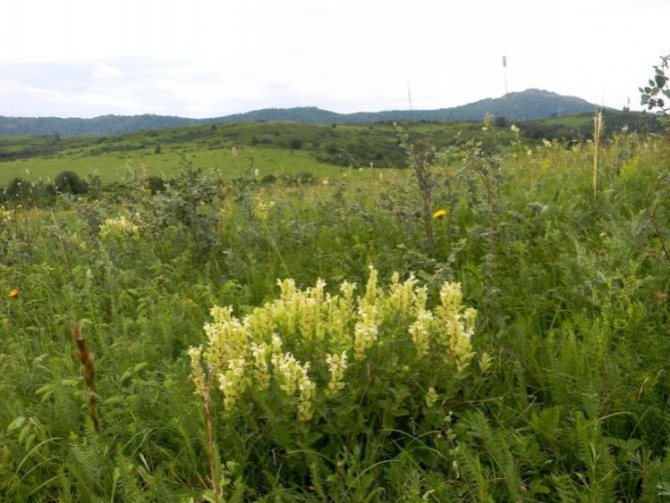

Perennial plant, which also has names: skullcap acutifoliate, adjacent skullcap. It grows in Russia (southern lands of the European part, Western and Eastern Siberia), Ukraine, Central Asia, Mongolia, China.
- It is a semi-shrub that grows up to 1.5 m in height.
- The leaves are oval in shape with jagged edges.
- The flowers are yellow, large (more than 3 cm in diameter), have hairiness.
Prefers to grow on high mountain slopes, valleys, steppe meadows. Flowers appear around June in the upper parts of the stems in the second year of growth.
Popular types
Ordinary
It is a perennial herb. Reaches a height of 10 to 50 cm. It has a tetrahedral stem, oblong-lanceolate leaves, on which there are wide obtuse notches. Flowering is represented by bluish-violet double-lipped flowers. They are located in the axils of the leaves, one flower at a time. The upper lip of the flower is helmet-shaped, and the lower lip is integral.
The flower has four stamens, two of which, the lower ones, are longer than the others. The pistil has a bipartite stigma and a four-lobed upper ovary. The fruit is represented by four nuts. Bloom lasts from June to August.
This species of skullcap grows near water bodies. It can be:
- floodplain meadows;
- swamps;
- banks of rivers and lakes, ponds.
Widely distributed in the European parts of Russia and the Caucasus.
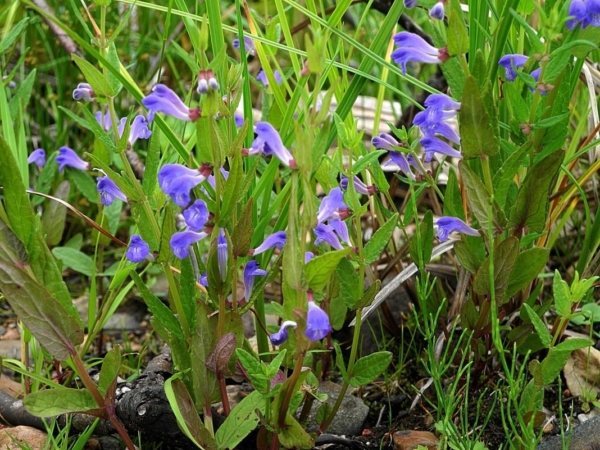

Siberian
It is a highly branched perennial plant., which has a large above-ground part, reaching one and a half meters in height. The stem is represented by numerous thin stems with a simple or branched apex. The leaves are simple. They are petioled, ovoid or ovoid-triangular in shape. Flowering is represented by small flowers of a dark red hue.
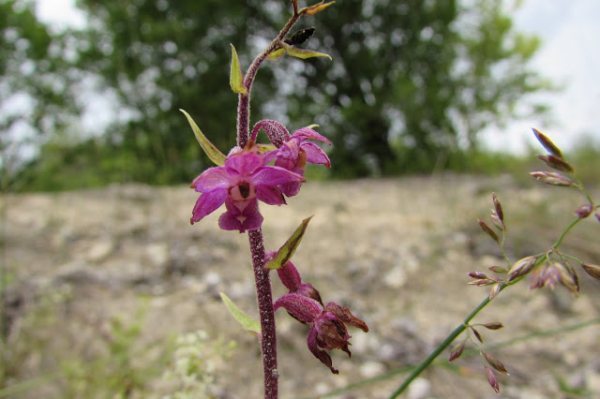

Alpine
The foliage is represented by whole, pubescent leaves, which are heart-shaped and opposite. It blooms with lilac-purple or blue flowers with a white throat. Flowering falls in May-July.
Very often this species is used as a decoration in combination with other ornamental plants:
Alpine skullcap grows forming loose curtainsso it looks great between stones.
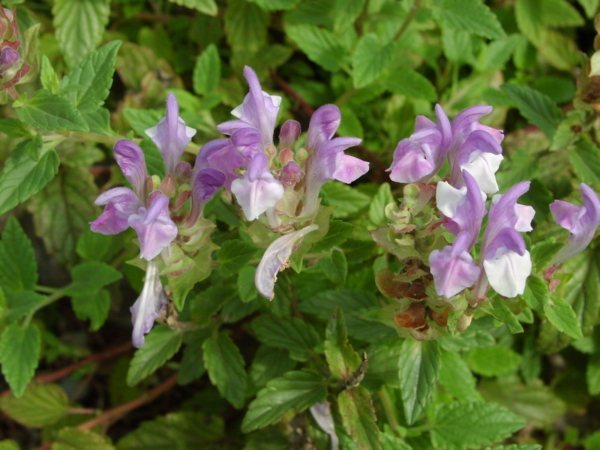

Another common name for this species is the Costa Rican Skullcap.
I would like to note that scarlet is the only plant of the skullcap species that can be safely grown indoors in pots. Thanks to its bright bloom, it will become a bright decoration for any room.
Another unique feature of this species is that flowering occurs only at the ends of the shoots.
In natural conditions, it is a perennial light-loving shrub with woody tetrahedral stems and reaching a height of up to a meter.
Botanical description
Skullcap Baikal belongs to the subshrub plants and the family of the Yaroslavl plants. In the people, the plant is called the squat scutellum, scutellaria, scutellaria, mother plant, blue St. John's wort. The Chinese and Asian versions of the name of the culture are zhen-leng and huang-qin. This herbaceous perennial crop 30 cm high and more has erect, tetrahedral, somewhat pubescent branchy stems.
The skullcap root is characterized by deep grooves in an upright position. The stem part holds short-petiolate, whole-extreme, crenate along the edge of the leaves and rather large, purple-colored, bell-shaped flowers. The flowering period occurs in the first decade of summer. The fruits are represented by small, spherical, black colored nuts, ripening in the autumn. The plant is most often found on the territory of Transbaikalia. The eastern and Siberian regions are also rich in this culture, where skullcap massively grows on sandy soils, rocky mountain slopes, in the steppes and along the banks of water bodies.
